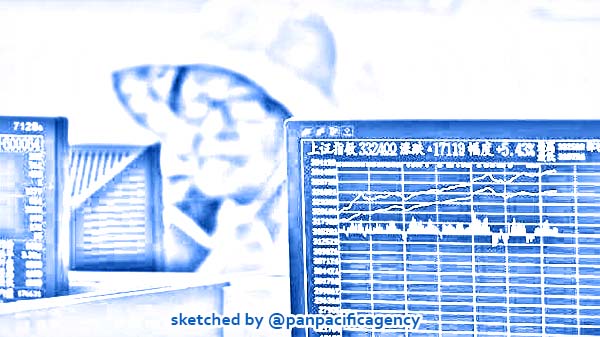[Analytics] How Covid-19 wreaked havoc on Southeast Asia’s stock markets

An investor watches computer screen at a stock exchange hall on July 6, 2020 in Fuyang, Anhui Province of China. Lu Qijian | VCG | Getty Images. Sketched by the Pan Pacific Agency.
Southeast Asia’s stock markets contracted after the coronavirus pandemic arrived in the region earlier this year. According to a report from Indonesian insurance company Lifepal comparing all nine regional stock markets—Brunei does not have an exchange—the average performance was -12.51% between January and August 2020. John Pennington specially for the ASEAN Today.
“There is not a single stock index in ASEAN that is moving positively in the past eight months,” the report noted. Amid economic uncertainty in the face of COVID-19, investor confidence disappeared. However, markets began to recover once governments eased lockdowns and economies got moving again.
Which markets suffered most and which are recovering best?
Singapore’s Straits Times Index (STI) was hit hardest, down 22% since the start of the year, and the report labels it the weakest of the markets it studied. The report puts its poor performance down to the drop-off of manufacturing due to a freeze on exports and declining tourism as well as severe lockdown conditions.
Meanwhile, its neighbors fared better as Bursa Malaysia (KLSE) is making the strongest recovery in Southeast Asia. It decreased at a rate of 3.86% after Malaysia’s government lifted lockdown conditions in June and announced a stimulus package to get the economy moving again.
No absolute link between COVID-19 case numbers and stock market performance
There is no consistent correlation between the number of COVID-19 cases and stock market performance. For example, Laos (22 reported cases at the time the report was published) and Thailand (3,411 reported cases) ranked seventh and eighth in terms of performance (-17.28 and -18.91% respectively). Singapore, while badly hit with 56,717 cases, performed worst, despite having three times fewer cases than Indonesia.
Meanwhile, the Philippines and Indonesia, the region’s worst-hit countries where cases are on the rise, ranked fifth and sixth respectively in terms of market contraction. After declining by 19.46% from January to July, Lifeco reported that Indonesia’s exchange (IDX) was showing signs of rebounding, with its contraction at 15.36% when considering data from January through August.
However, after Indonesia’s government announced a return to lockdown conditions from today (September 14), there was an immediate drop of around 5%, wiping out that recovery. Indonesia’s experience serves as a warning that should cases continue to rise in the region, lockdown measures will once again lead to stock markets contracting sharply, which will further dampen investor confidence. “While there are lockdowns happening it’s difficult to put extra money there, not knowing how long you’re going to wait for,” said Sean Taylor, chief investment officer in Asia for German firm DWS.
Vietnam’s stock market was the only other exchange in the region on an upward trajectory, per the Lifepal report, partly thanks to the government’s swift action to control the spread of the virus. “The government of Vietnam has also implemented drastic measures to socialize as well as minimizing the possibility of cross infection,” said Le Duc Khanh, chief economist and strategic director of Vietnam’s Petroleum Securities Joint Stock Company. “This is probably the most positive policy impact to bring confidence to the people and will also help investors have better mindset,” he added.
Confidence in the stock markets is slowly returning
Malaysia, the Philippines, Singapore and Thailand were officially in recession after they reported negative growth across the first two quarters of the year. Rising cases of COVID-19, uncertainty about whether countries will have to reimpose lockdown conditions and the slow progress towards a vaccine has put investors off.
Furthermore, experts and ministers do not expect the region’s economies to recover quickly. However, some analysts do not expect the markets to continue declining at the current rate if governments can keep economies moving. With stocks at low rates and economists predicting that markets will follow those in Europe and the US by bouncing back, there are opportunities for investors to pick up bargains.
UBS’ Global Wealth Management’s Kelvin Tay believes that the STI is “undervalued” and that now is a good time to invest. “We do think where the [Straits Times’ index] is concerned, there is a lot of value in some of the stocks,” he said. Oil and technology stocks are in demand, and purchasing of these stocks at lower prices might stimulate struggling markets.
A lack of technology stocks could hinder recovery
However, Southeast Asian stock markets are less attractive than others because they do not include significant numbers of technology stocks. Those stocks are rallying and driving market recovery elsewhere in the world, for example, in China and the US. They comprise just 11% of Southeast Asia’s markets compared to almost one-third in the US’s S&P 500 index and around one quarter in the MSCI Asia Pacific index.
“As long as [the] tech rally lasts, Southeast Asia will continue to underperform due to a lack of those companies,” warned Nirgunan Tiruchelvam, head of consumer equity research at Tellimer. And the outlook is for more of the same, at least in the short-term. “Given the high representation of cyclical stocks in the mix, short-term under-performance could sustain,” said Jingyi Pan, an IG Asia Pte. market strategist.
With the potential for lockdown conditions to return if COVID-19 cases increase at any point—as they did in Indonesia—it is clear why investors are holding off. For now, the risks are too high, and the potential returns are too low. Expect investors to treat Southeast Asia’s stock markets with caution, leading to a slow recovery, at least until the development of a COVID-19 vaccine.